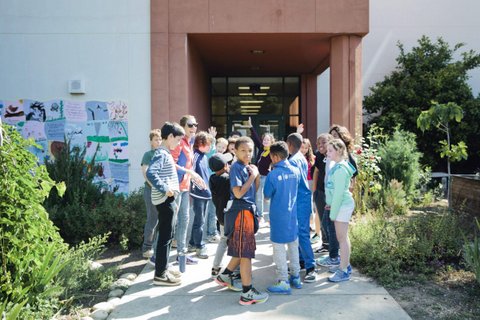
25 Aug EdSource: California Joins Effort to Cut Chronic Absenteeism in Half by 2030

Fourth graders in the garden at Redwood Heights Elementary School in Oakland on May 17, 2017. (Alison Yin for EdSource)
By Mallika Seshadri and Betty Marquez Rosales
EdSource
After years of working to restore students’ attendance rates in the aftermath of the Covid-19 pandemic, State Superintendent of Public Instruction Tony Thurmond announced that California is on track to cut chronic absenteeism by half in the next five years.
To help districts meet that goal, the state Department of Education has issued a California Attendance Guide. The effort comes as part of a partnership with Attendance Works and the California Collaborative for Educational Excellence.
Other regional agencies, including the Los Angeles County Office of Education, have chimed in with their own resources, including their Attendance Awareness Toolkit and Student Attendance Playbook.
While recognizing the challenges and anticipating setbacks, especially in the face of ongoing immigration enforcement, several policymakers and stakeholders have expressed optimism that California will ultimately reach its goal.
“Many of you Californians, like me, have been to Yosemite Falls. And that first approach is easy. It’s beautiful. … But to get to the top of the falls, that’s the hardest,” said Cecelia Leong, vice president of programs at Attendance Works, during a press conference Tuesday. “That’s the sort of goal that we have set for ourselves. … We’ve done some of the hard work, and it’s going to take even greater effort as we move forward.”
During 2018-19, the school year before the onset of the pandemic, the chronic absenteeism rate in California was 12%. It peaked at 30% in 2021-22, a year during which schools had, by and large, reopened after the widespread closures at the height of the Covid-19 pandemic.
Since then, chronic absences have decreased year over year, dropping to 20% during the 2023-24 school year, according to the most recent state data available.
But most states remain far from their pre-pandemic rates, which led a group of education organizations to launch a campaign last year asking that states pledge to cut chronic absenteeism by half over five years. Initially, 14 states joined the campaign organized by Attendance Works, EdTrust and the American Enterprise Institute; California is one of the latest to join.
When breaking down the data by race/ethnicity, however, rates vary widely.
A report published Friday by researchers at the University of Southern California also found that despite roughly 1 in 5 California students being chronically absent, rates for Black, Native Americans and Pacific Islander students remained closer to 1 in 3.
“Chronic absenteeism isn’t just a random phenomena or dynamic,” said Kendrick Davis, a professor at USC’s Rossier School of Education, who served as an editor on the report. “It tends to increase during vulnerable periods of transition, like when students are going from middle school to high school, but also in vulnerable subpopulations, sometimes by age group.”
Legislative efforts
Chronic absences often destabilize school funds, a concern that Senate Bill 98, signed into law last year, seeks to address.
Under California’s funding policy, school districts receive funding in part based on average daily attendance, commonly known as ADA.
>>>WCCUSD Proposes More Cuts, Says Higher Attendance Could Prevent Them<<<
As such, the higher the rate of chronic absenteeism, the more funding may be cut from what any given school district might receive as a result of attendance.
SB 98 seeks to address the issue by shifting funding from average daily attendance to average daily membership, which would be based on student enrollment. Previous efforts to shift to enrollment-based funding have failed.
The effects of that shift are to be examined by the Legislative Analyst’s Office in a report it is required to publish by Jan. 1, 2026.
In the meantime, districts now have the option to offer attendance recovery programs that allow students to make up for their absences by attending supplemental classes. Schools may offer those classes before or after school, during weekends, or during intersession breaks.
The new policy allows districts to recoup ADA funding they would have otherwise lost entirely.
This new option is in effect for the current school year.
A local approach
Students are considered chronically absent once they miss 10% or more of the school year. It’s a number they reach due to a wide range of reasons: ongoing mental health challenges, instances of bullying, painful monthly menstruation cycles, and more.
Families have also reported living with unmet basic needs, which can impede their children’s ability to get to school. These could include inconsistent housing, insufficient food, or unpredictable access to transportation.
And in the more rural parts of the state, a student requiring specialized medical attention may need to travel a far distance, making it challenging to return to school within a reasonable timeframe, or at all for the day.
Chronic absenteeism in Merced County’s Livingston Union School District rose to an all-time high during the 2022-23 academic year, impacting 18.3% of students.
According to EdData, that number fell to 13.9% a year later, garnering the district recognition for its progress.
In the wake of the pandemic, Maria Torres-Perez, the district’s director of categorical programs and attendance supervisor, said many parents were hesitant to bring their child to school, even if they sustained minor symptoms like a cough or stomach ache.
It took time, she said, to address parents’ concerns and reassure them.
Still, she attributes roughly half of their district’s cases of chronic absenteeism to students’ real or perceived medical challenges.
“If a child stays home one day with a mild tummy ache, then they are more likely to stay home two and three and four days, because they get used to it. They get comfortable,” Torres-Perez said. “Certainly, as adults, we can relate to that. … There are some routines and comforts at home that if we get used to them, it’s harder to then think of leaving the house … and going where we need to go.”
So, the district responded directly to parents’ concerns about their students’ medical well-being: communicating frequently with parents while their children are on campus and increasing medical staff, both at the school and district levels.
Livingston Union also boosted its counseling staff and has worked toward preventative measures, including inviting parents onto their child’s campus for a meeting if their student is on track to become chronically absent.
And they aim to celebrate a student’s progress, Torres-Perez said.
“Hey, the first month wasn’t a great month for attendance, [but] you did make it to the perfect attendance list. … Look how far you’ve come,” Torres-Perez said as staff seek to congratulate students. “You’ve only missed one day this month. Look at that growth. Good for you!”
Recommendations and guidance
Over the years, there has been a shift away from punitive, legal approaches when it comes to chronic absenteeism — moving instead toward more holistic support for students and their families.
And as of July, with the passage of Senate Bill 691, schools are required to change their messaging to parents, replacing traditional truancy notices with those that offer information about available resources, including mental health support.
“This is not a tug-of-war with parents or caregivers or kids themselves to try to get them to class,” said Alicia Garoupa, the chief of well-being and support services at the Los Angeles County Office of Education. “It’s creating conditions where they want to be there that are going to really move the mountain.”
She also emphasized the importance of taking a holistic approach toward supporting students, empowering youth leaders and helping students feel a sense of belonging on their campus.
“Sometimes with attendance, we kind of get stuck treating the individual student or their situation and the barriers, and we absolutely have to do that,” Garoupa said. “But if we never go upstream and really work on treating the systems themselves … we’re going to keep getting similar results.”
Copyright © 2025 Bay City News, Inc. All rights reserved. Republication, rebroadcast or redistribution without the express written consent of Bay City News, Inc. is prohibited. Bay City News is a 24/7 news service covering the greater Bay Area.






No Comments